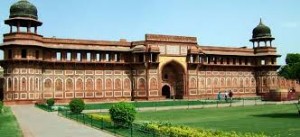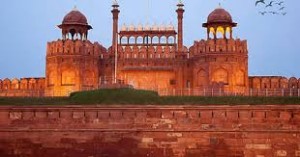
Top ten mughal monuments
Indian architecture was greatly enchanced under the Mughal rule.All the early Mughal Rulers except Aurangzeb were great builders.Indian architecture at that time was greatly influenced by Persian styles. The Mughals constructed excellent mausoleums, mosques, forts, gardens and cities that are till date admired. The Mughal buildings show a uniform pattern both in structure and character. Mughal architecture reached its zenith during the reign of emperor Shah Jahan (1628-58) its crowning achievement being the magnificent Taj Mahal.
10) FATEHPUR SIKRI

Fatehpur sikri is a city in Agra district in Uttar Pradesh.The city was founded in 1569 by the Mughal emperor Akbar and served as the capital of the Mughal Empire from 1571 to 1585.The city contained some of the most beautiful buildings – both religious and secular which testify to the Emperor’s aim of achieving social, political and religious integration. The religious edifices at Fatehpur Sikri are the Jami Masjid and Salim Chisti’s Tomb.
9) SIKANDRA

Sikandra, located only 13 km. from the Agra Fort is the last resting place of the Mughal emperor Akbar.It is also called as “THE TOMB OF AKBAR THE GREAT”.Its construction was started by akbar and completed by his son Jahangir.Akbar himself planned his own tomb and selected a suitable site for it.This structure has a perfect blending of Hindu, Christian, Islamic, Buddhist, Jain themes. Sikandra was named after Sikandar lodi, the Delhi ruler.
8) AGRA FORT

Agra Fort is a UNESCO World Heritage site located in Agra, Uttar Pradesh, India. It is about 2.5 km northwest of its more famous sister monument, the Taj Mahal. The fort can be more accurately described as a walled city.The structure was built by Akbar.Some important buildings inside Agra Fort are Moti masjid, Meena bazaar and Jahangiri mahal built for Jahangir and his family.
7) BULAND DARWAZA

A magnificent gateway was added by Akbar later in 1571-72 to commemorate his conquest of Gujarat. Built of red sand stone and marble it is said to be the “most perfect architectural achievement in the whole of India”. An inscription on the gateway testifies to Akbar’s religious toleration.
6) HUMAYUN’S TOMB

It was built in 1565 A.D. fourteen years after the death of Humayun, by his senior widow Haji Begam.There are several graves of Mughal rulers located inside the walled enclosure and from here in 1857 A.D. ;it has also captured the last Mughal emperor
Bahadur Shah II.Planned by a Persian architect and constructed by Indian workers, it is a combination of both Persian and Indian styles of architecture. Entrance to the mausoleum is through two double storeyed gateways.
5) ITMAD-UD-DAULA’S TOMB

Tomb of Itimad-ud-Daula is a Mughal mausoleum in the city of Agra built on the bank of river Yamuna. Often described as a ” jewel box”, sometimes also called as the “Baby Taj”, the tomb of Itimad-ud-Daula is often regarded as a draft of the Taj Mahal.The mausoleum was commissioned by Nur Jahan, the wife of Jahangir, for her father Mirza Ghiyas Beg, originally a Persian Amir in exile. Mirza Ghiyas Beg was also the grandfather of Mumtaz Mahal.
4) RED FORT

The Red Fort was the residence of the Mughal emperors of India for nearly 200 years, until 1857.The Red Fort was built as the fortified palace of Shahjahanabad, capital of the fifth Mughal Emperor Shah Jahan in 1648. The Red Fort is an iconic symbol of India. On Independence Day, the prime minister hoists the national flag at the main gate of the fort and delivers a nationally-broadcast speech from its ramparts.Some of the beautiful buildings inside the fort are the Diwan-i-Am, Diwan-i-Khas, Moti Mahal, Hira Mahal and Rang Mahal.
3) JAMA MASJID

Jama Masjid literaly means the world’s reflecting mosque.It is is the principal mosque of old Delhi commissioned by the Mughal Emperor Shah Jahan, it is the largest and best-known mosque in India.It was built between 1650-1656 A.D. The cost of this mosque at the time period of Shah Jahan was estimated to be about 1 million rupees.
2) QUTUB MINAR

Located in Delhi, the Qutub Minar is made of red sandstone and marble.Its Construction was started in 1192 by Qutb-ud-din Aibak and was carried on by his successor, Iltutmish. In 1368, Firoz Shah Tughlaq constructed the fifth and the last storey of the minar.This soaring conical tower is an equisite example of Indo-Islamic Afgan architecture and the verses from the holy Quran are carved on sandstone walls of Qutub Minar.
1) TAJ MAHAL

Taj Mahal is called the “crown of palaces”.It was built by Shah Jahan in memory of his third wife, Mumtaz Mahal.Built on the banks of the river Yamuna, it was started in 1632 A.D. and took 22 years to complete. The Taj Mahal is widely recognized as “the jewel of Muslim art in India” and is one of the universally admired masterpieces of the world’s heritage.Taj Mahal is regarded by many as the finest example of Mughal architecture that combines elements from Islamic, Persian, Turkish and Indian architectural styles.
-
Mustafa
-
Rajdeep Tyagi
-
-
GDHGDHHD
-
Rajdeep Tyagi
-
anusha fayaz
